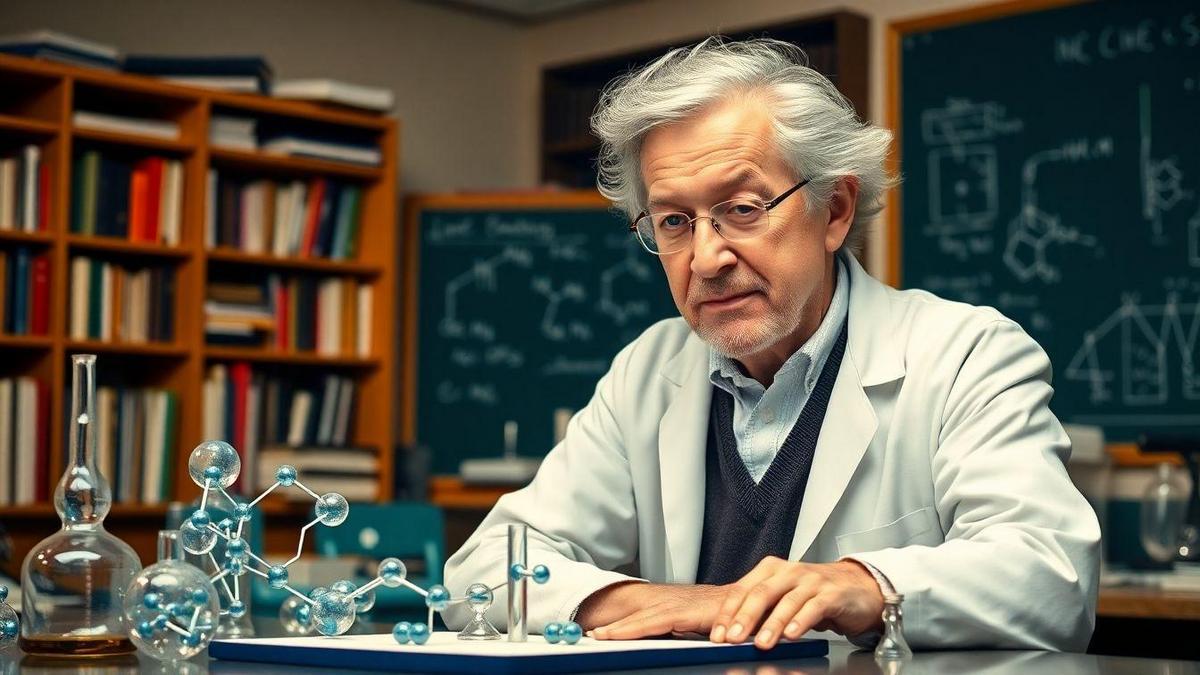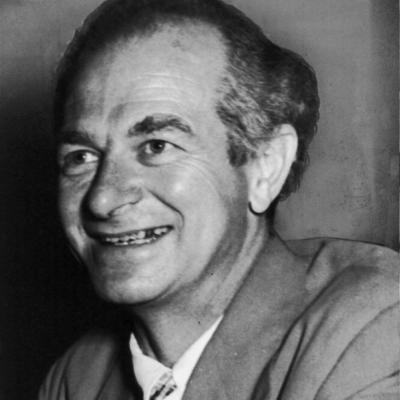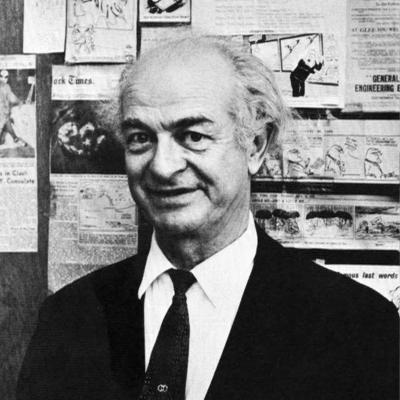Anúncios
Linus Pauling was one of the most influential scientists of the 20th century, being fundamental to the advancement of chemical and biological sciences. His work created a bridge between chemistry and molecular biology, enabling the understanding of biological processes at the molecular level. Through his discoveries, Pauling not only influenced the structure of biological molecules but also revolutionized the way we understand the functions of these molecules in living systems.
Pauling’s contribution to the development of molecular biology was marked by the application of quantum chemistry concepts to biology. His studies on the molecular structure of proteins, atomic orbital hybridization, and electronegativity made it possible to create new research methodologies. These innovations not only clarified molecular interactions but also opened doors for new therapeutic and technological approaches in medicine and biotechnology.
Anúncios

Linus Pauling and the Bridge Between Chemistry and Molecular Biology
Linus Pauling was a pioneer in integrating chemistry with molecular biology. His work focused on the importance of the three-dimensional structure of molecules to understand how they function in biological systems. He revealed that the shape of molecules, especially proteins, is essential for their functions, a concept that changed the way molecular biology is studied.
By applying quantum chemistry principles to biology, Pauling introduced the idea that the reactivity of molecules is determined by the arrangement of atoms in their structure. This breakthrough was essential for understanding how proteins interact with other biological molecules, such as enzymes and nucleic acids, and helped establish the foundations for future research in biotechnology.
In addition, Pauling helped clarify the nature of chemical bonds between atoms, showing how they influence the properties of biological molecules. His theory of orbital hybridization was crucial in explaining the shapes of protein molecules and their interactions, which made it possible to study proteins in greater detail.
His work with X-ray crystallography also had a profound impact, allowing scientists to visualize the atomic structures of complex molecules. This experimental technique, along with Pauling’s theoretical models, provided a new way to explore the molecular interactions that govern biological processes.
Hybridization and Protein Structure
Pauling’s theory of orbital hybridization was a milestone in understanding chemical bonds. He explained how atomic orbitals combine to form new orbitals that determine the shape of molecules. This concept was essential in unraveling how proteins take on their complex shapes and how these shapes affect their biological functions.
Orbital hybridization helped explain the geometry of protein molecules, particularly the alpha-helix and beta-sheet structures. These structures are fundamental to the functioning of proteins because they influence how proteins interact with other molecules within cells. Thus, Pauling provided a foundation for the structural analysis of proteins that remains essential today.
The study of protein structures was also enhanced by Pauling through the application of mathematical models. He showed how these structures form from molecular interactions, such as hydrogen bonds, which keep proteins stable. This understanding helped connect the structure of proteins with their biological functions, such as catalyzing chemical reactions and transporting molecules.
Additionally, Pauling’s discovery of the structural forms of proteins led to the development of new methodologies for studying other biological macromolecules. X-ray crystallography, which he helped popularize, became a fundamental tool for researchers to understand the three-dimensional structure of complex biological molecules.
Electronegativity and Its Biological Implications

Pauling’s theory of electronegativity also played a key role in molecular biology. He proposed that electronegativity is the tendency of an atom to attract electrons when forming a chemical bond. This idea has profound implications for biology, as it influences how molecules interact within living organisms.
In biological systems, electronegativity can affect how protein molecules interact with other molecules, such as enzyme substrates or cofactors. Understanding these interactions is crucial for the discovery of new drugs and therapies, as many diseases are related to defective molecular interactions. Therefore, the concept of electronegativity became essential for the development of molecule-based therapies.
The influence of electronegativity extends beyond interactions between proteins and other biological compounds. It also affects how molecules behave in aqueous solutions, a crucial environment for life. Pauling demonstrated how the attractive forces between atoms in a molecule affect the solubility and reactivity of biological substances, providing valuable insights into biochemistry.
These discoveries not only enhanced the understanding of molecular interactions but also facilitated the development of predictive models in molecular biology. This paved the way for the design of more effective molecular therapies, based on a deeper understanding of the forces that govern interactions between biomolecules.
How Linus Pauling and the Connection Between Chemistry and Molecular Biology Works
Linus Pauling, a prominent figure in the fields of chemistry and molecular biology, revolutionized our understanding of the molecular structure of proteins and the nature of chemical bonds. His work laid the foundation for the modern study of molecular biology, providing insights into how the structure of molecules relates to their functions in biological systems. Pauling’s research emphasized the importance of the three-dimensional arrangement of atoms within molecules, crucial for understanding how proteins interact with each other and with other biological macromolecules.
Pauling’s approach to connecting chemistry and molecular biology involved applying quantum mechanics to chemical bonding. He introduced the concept of hybridization, which explains how atomic orbitals combine to form new orbitals that dictate the shape and reactivity of molecules. This concept was essential for understanding the structure of proteins, particularly the alpha-helix and beta-sheet formations, which are key to protein architecture. By revealing the underlying principles of molecular structure, Pauling provided a framework for researchers to explore the biochemical pathways that govern cellular processes.
Furthermore, Pauling’s work on the nature of chemical bonds led to the development of the concept of electronegativity, which describes an atom’s tendency to attract electrons. This idea has profound implications in molecular biology, as it affects how molecules interact within biological systems. Understanding these interactions is essential for elucidating metabolic pathways and enzyme mechanisms. Pauling’s interdisciplinary approach not only advanced the field of chemistry but also paved the way for future discoveries in molecular biology.
In addition to his theoretical contributions, Pauling was also a pioneer in the use of X-ray crystallography to study the structures of biological molecules. This technique allowed scientists to visualize the arrangement of atoms in complex molecules, providing valuable insights into their functions. By combining experimental techniques with theoretical models, Pauling helped establish a new paradigm in scientific research, one that emphasized the interconnectedness of different scientific disciplines.
How to Understand Linus Pauling and the Connection Between Chemistry and Molecular Biology

To fully understand the significance of Linus Pauling’s contributions to chemistry and molecular biology, it is necessary to consider several key aspects of his work. First, understanding the principles of chemical bonding is essential. Pauling’s introduction of hybridization and electronegativity provides a fundamental framework for interpreting molecular interactions. Familiarizing oneself with these concepts will enhance the ability to appreciate the complexities of biological systems.
Second, it is important to recognize the role of structural biology in molecular biology. Techniques such as X-ray crystallography and nuclear magnetic resonance (NMR) spectroscopy have been fundamental in elucidating the structures of proteins and nucleic acids. By studying the three-dimensional arrangements of atoms, researchers can gain insights into how these molecules function within living organisms.
Study the fundamentals of chemical bonding: Familiarize yourself with concepts such as covalent bonds, ionic bonds, and intermolecular forces. Understanding these principles will provide a solid foundation for exploring molecular interactions.
Explore hybridization: Learn about the hybridization of atomic orbitals and how it affects molecular geometry. This knowledge is crucial for understanding the shapes of biological molecules and their interactions.
Investigate electronegativity: Study how electronegativity influences molecular behavior and reactivity. This concept is vital for understanding how molecules interact in biological systems.
Dive into structural biology: Familiarize yourself with the techniques used to determine the structures of biological macromolecules. Understanding structural biology methods will enhance your appreciation of the relationship between structure and function.
Engage with computational biology: Explore the role of computational models in predicting molecular behavior. Becoming familiar with computational tools will help you understand how researchers simulate biological processes.
Stay updated on interdisciplinary research: Keep up with advances in fields that connect chemistry and molecular biology. Being aware of new discoveries will deepen your understanding of the interconnection between these disciplines.
By engaging with these key areas, one can develop a comprehensive understanding of Linus Pauling’s contributions and the broader implications of connecting chemistry with molecular biology. This knowledge not only enriches scientific literacy but also highlights the importance of interdisciplinary approaches in solving complex biological issues.
Did You Enjoy Learning About Linus Pauling and the Connection Between Chemistry and Molecular Biology?
Learning about Linus Pauling and his role in connecting chemistry and molecular biology is an inspiring journey through the complexities of science. His groundbreaking work not only transformed our understanding of molecular interactions but also paved the way for future discoveries that continue to shape the life sciences field.
As you dive deeper into this fascinating subject, you will uncover the profound impact of interdisciplinary research on our understanding of life. Linus Pauling’s legacy serves as a reminder of the importance of curiosity, collaboration, and innovation in the pursuit of knowledge.
Frequently Asked Questions
What is Linus Pauling and the connection between chemistry and molecular biology?
Linus Pauling was a famous chemist. He helped unite chemistry with molecular biology. He used chemistry to understand how cells work.
Why is Linus Pauling important in science?
Pauling won two Nobel Prizes. One in Chemistry and the other for Peace. He made many discoveries that changed science.
How did Linus Pauling help understand proteins?
Pauling discovered how proteins fold. This is important to know how they function. His studies helped explain protein structure.
What is Linus Pauling’s impact on medicine?
His ideas are behind new therapies. He helped understand diseases. This opened doors for new treatments.
Linus Pauling and vitamin C research, what’s the connection?
Pauling believed vitamin C could prevent diseases. He did many studies on this. His research sparked debates and new investigations into vitamins.
